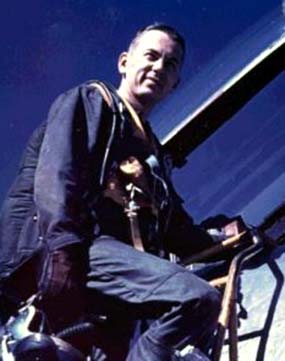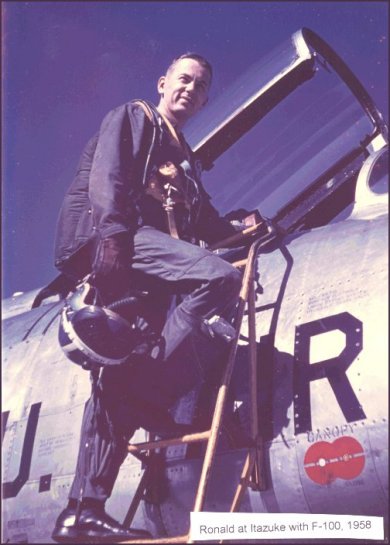In 1958, Ron Herrick flew the F-100 with the 35th Tactical Fighter Squadron out of Itazuke, Japan.
Ron Herrick “Headed West” on April 4, 2011.
Ronald C. Herrick – Caterpillar Club

Ejection From F-100D-20NA 55-3538, 28 Oct 1958, Sea of Japan
In 1958, I was at Itazuke AB, Japan in the 35th TFS, flying the F-100D. 1st Lt. Craig, my wingman, and I were on a scheduled air defense exercise to intercept USAF aircraft exiting Korea. We were scrambled for an afterburner climb and we proceeded north to intercept what turned out to be an RB-66 at about FL 350 doing about M .92. We made a turn around to make a Sidewinder pass and since we were clean, we maxed out at about M 1.3. (The aircraft had only about 300 hrs, so airframe-wise, it was a fairly hot airplane). I remembered and related in the debriefing that I felt 2 or 3 slight pitch transients during the supersonic period. After the intercept, we proceeded to recover, as we had really used the fuel.
Descending through about 12,000 at 300 KIAS, about 40 miles north of Itazuke, I experienced an uncommanded pitch up which I could not stop with forward stick and trim. (Since I had stick feel and trim, the board determined very closely the point of disconnect.) My wingman confirmed the stabilizer was full nose down. Using power and roll I made a series of what I called lazy eights. I related to the ground control everything that I observed. I had pitch trim, and pitch trim authority, the stick would move, the hydraulics were showing full flow over 3,000 psi.
It was obvious that I could not land, and the squadron agreed. The prompting from the squadron over the radio about what to check was outstanding, and I ejected at a comfortable 300 knots. The sequence was initiated by raising the handles, placing the hands underneath the handles and pulling up. (On the F-100D there is a mechanical latch to prevent raising the handles accidentally). Raising the armrests jettisons the canopy and exposes the triggers. I looked down to see if I had repositioned my fingers to the now exposed triggers, and that is how I exited the plane, head down.
We had been briefed that pilots did not escape because they did not pull the triggers, but because they had not repositioned their fingers to grasp the triggers, which is not accessible with the armrest down. No need to elaborate, I had a very sore neck, but a beautiful view leaving the cockpit. Everything worked as advertised. The seat belt released and the butt snapper popped me out of the seat, pulling the auto parachute release: (D ring not connected to snap). About 10 feet above the cockpit I had already rotated about 90 degrees, and I was looking down into the empty cockpit. I remember wondering if I was going to clear the tail. After the chute billowed out. I insured the raft and survival kit were deployed, but I could not bring myself to open the guards on the quick release.
At first, I felt insecure but began to feel more comfortable as I descended. I remembered that I had a 16 mm miniature camera in my G-suit pocket, so I got it out and took a few pictures on the way down. (I really caught some flak from that) As soon as I ejected, the rescue effort was set in motion. Since this was a scheduled exercise, the rescue effort was at its peak. An H-19 was on alert, as was an HU-16 amphibian. (GREAT: The problem was that the H-19 had problems and there were 12-foot swells and the HU-16 could not operate in that sea state.)
Meanwhile, I jettisoned my chute as the life raft hit the water, but as I remember, my feet hit the water at the same time the chute dumped. I went under, surfaced, and began to unbuckle the harness because the survival kit was not floating as advertised. I got the chest and left leg buckles open but the survival kit was pulling me under because the right leg strap was hung up on the G-suit pocket. I gave up on getting out of the harness and pulled the raft to me. It took a lot of energy to get in the raft and I barely made it.
Fortunately to my surprise, a Japanese fishing boat crew saw me eject and descend. They motored over to me and hauled the gear and me into the boat. That was the most beautiful boat that I have ever seen. The rescue effort was stalled by the lack of machines, but my wingman reported that I appeared to have been picked out of the water by a fishing boat and I had waved to him. The emergency UHF radio never did work.
Unknown to the entire operation, there was an H-21 on an unrelated mission of documenting with photos the helicopter landing sites at the radar stations, which that outfit supported. There were four aircraft in the detachment, and as luck would have it, this was the only one with the hoist and sling. The pilot, Lt. Grant Mackie was my next-door neighbor and he heard the chatter on guard channel. When he heard what was going on, the lack of a pickup effort, he volunteered that he had a sling and would gladly help. He was vectored to my position, and using the hoist, picked me up off the boat by sling; the pickup was well-documented by the photographer and I was in the hospital in about an hour.
The airplane was not recovered, but the accident board had sufficient information to reasonably determine the cause. A mod had been performed on the aircraft, which replaced the fiber lock nuts in the flight control system with a castellated nut, which requires a cotter pin to be inserted through the nut and bolt to secure the assembly. It was assumed that the pin was either not installed or improperly installed, the nut backed off and a bolt came out. The pitch oscillations I felt during the supersonic run were probably the bolt coming out.
TRIVIA: The next spring I had to go to sea survival school, which for me was a three-day debriefing on survival. The whole squadron was waiting for me to land so that the squadron could be presented with an accident-free Flight Safety Award. When they heard I had ejected, they all said OH ____and went home. The 8th TFW honored the fishing boat crew. My Wing commander and I were there and presented the crew’s captain with a written commendation and a fair amount of money. I visited Japan 2 years ago and found that fisherman. An American teacher, Wes Injurd, with whom I was corresponding, spent a lot of time arranging for the media coverage and arranged the meeting. I was fortunate to find him, but it was made easier to find him, as he lived in the same house. It was quite a deal, and it was all on TV. I still have the D ring as the automatic devices all worked which bypassed the D ring. The airman who packed the chute indicated it was the first one that he had packed that was used. He was very young and I felt that I should have given him a gallon of ice cream instead of the traditional booze.
-Ron Herrick




